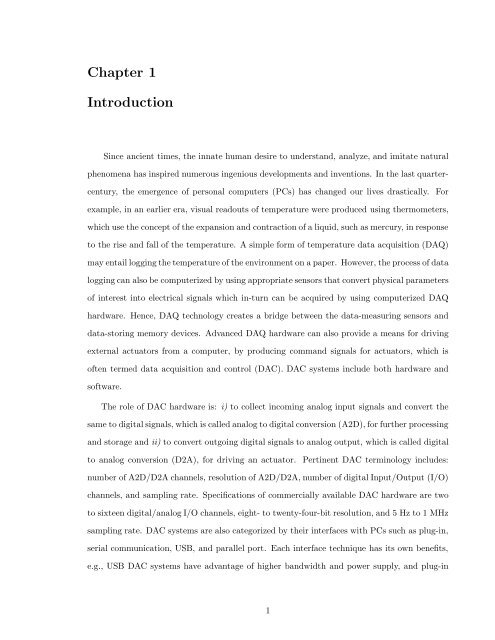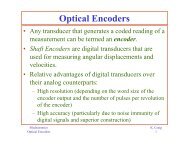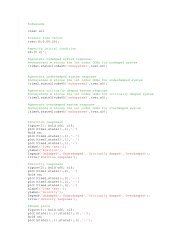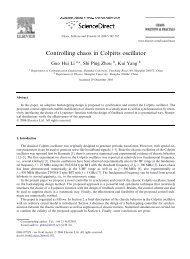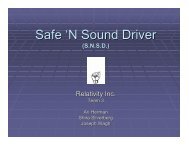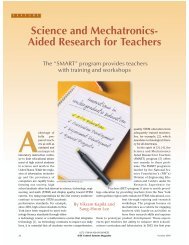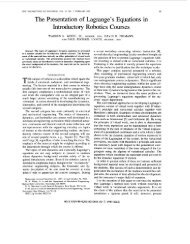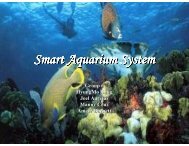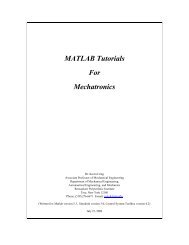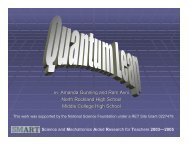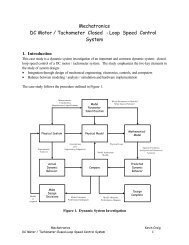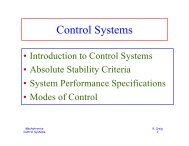Chapter 1 Introduction - Mechatronics
Chapter 1 Introduction - Mechatronics
Chapter 1 Introduction - Mechatronics
You also want an ePaper? Increase the reach of your titles
YUMPU automatically turns print PDFs into web optimized ePapers that Google loves.
<strong>Chapter</strong> 1<strong>Introduction</strong>Since ancient times, the innate human desire to understand, analyze, and imitate naturalphenomena has inspired numerous ingenious developments and inventions. In the last quartercentury,the emergence of personal computers (PCs) has changed our lives drastically. Forexample, in an earlier era, visual readouts of temperature were produced using thermometers,which use the concept of the expansion and contraction of a liquid, such as mercury, in responseto the rise and fall of the temperature. A simple form of temperature data acquisition (DAQ)may entail logging the temperature of the environment on a paper. However, the process of datalogging can also be computerized by using appropriate sensors that convert physical parametersof interest into electrical signals which in-turn can be acquired by using computerized DAQhardware. Hence, DAQ technology creates a bridge between the data-measuring sensors anddata-storing memory devices. Advanced DAQ hardware can also provide a means for drivingexternal actuators from a computer, by producing command signals for actuators, which isoften termed data acquisition and control (DAC). DAC systems include both hardware andsoftware.The role of DAC hardware is: i) to collect incoming analog input signals and convert thesame to digital signals, which is called analog to digital conversion (A2D), for further processingand storage and ii) to convert outgoing digital signals to analog output, which is called digitalto analog conversion (D2A), for driving an actuator. Pertinent DAC terminology includes:number of A2D/D2A channels, resolution of A2D/D2A, number of digital Input/Output (I/O)channels, and sampling rate. Specifications of commercially available DAC hardware are twoto sixteen digital/analog I/O channels, eight- to twenty-four-bit resolution, and 5 Hz to 1 MHzsampling rate. DAC systems are also categorized by their interfaces with PCs such as plug-in,serial communication, USB, and parallel port. Each interface technique has its own benefits,e.g., USB DAC systems have advantage of higher bandwidth and power supply, and plug-in1
2DAC systems yield high acquisition rates since they use the PC bus directly. For example,Quanser’s [1] Q4 [2] plug-in DAC board is equipped with four A2Ds, four D2As, sixteen digitalI/Os, fourteen-bit input resolution, and twelve-bit output resolution. Yet another plug-in DACboard from National Instrument [3] is NI PCI-7831R [4], which is configured with eight analogI/Os, ninety-six digital I/Os, and sixteen-bit input resolution.DAC hardware without software is of little use. DAC systems require low-level hardwarefunction calls performed by driver software to interface application software with DAC hardwarefor proper controls.specified sampling rate.With appropriate software, DAC systems can acquire data at aThe driver and application software are usually supplied by DAChardware vendors, and measurement and control software can be developed by using a varietyof text-based programming languages such as BASIC, C, FORTRAN, and Java.By usingsuch measurement and control software, acquired data from DAC boards can be displayed,analyzed, and stored on a computer. For example, LabVIEW [5] identifies, configures, andcontrols DAC board hardware by a device number, and interfaces inputs from various sourcessuch as serial and parallel ports. In addition, it provides a user-friendly graphical user interface(GUI) for developing complete instrumentation, data acquisition, analysis, and controlfunctions. Similarly, MATLAB/Simulink [6] enables processing of the acquired data withoutnecessitating the use of text-based programming languages, since it provides built-in graphicaltools and libraries for data acquisition, control, and analysis.The DAC technology is continuously being advanced toward being more accurate, reliable,effective, efficient, and low-cost. It is envisioned that in future low-cost, small form factor DAChardware will become available, allowing DAQ technology to become portable and pervasiveby being embedded in hand-held computers, PDAs, and mobile phones.However, currentDAC systems tend to be quite expensive (and not very portable.) In a recent price comparisonof several MATLAB and Simulink supported PC-based DAC boards of different form factors(e.g., PCI, ISA, and PCMCIA), we determined that these DAC boards cost from five hundredto several thousand dollars. Furthermore, academic labs generally do not require the intrinsichigh performance features of these DAC systems (e.g., high sampling rates, high resolutionA2Ds, etc.) to educate students. The expensive DAC systems that have high sampling rates
3and high resolution are sometimes not necessary for simple tasks. Therefore inexpensive DACsystems are highly desirable for educational purposes.In contrast to the PC-based DAC boards, microcontrollers are inexpensive devices (costingonly a few tens of dollars), which are widely used for embedded computing. However, amajority of microcontrollers require programming using an embedded programming variant ofone or another high-level programming languages (e.g., BASIC, C, Java, etc.). In addition,many low-cost microcontrollers do not allow floating-point numerical computations that maybe needed to implement advanced feedback control algorithms. Therefore, a marriage of inexpensivemicrocontrollers and user-friendly software such as LabVIEW and MATLAB willenable relatively inexpensive DAC systems to be created.The first part of this dissertation addresses design and development of a MATLAB andSimulink-based software platform that enables the use of inexpensive microcontrollers for DACtasks. Motivated by the current trend toward user-friendly environment, we exploit Simulink’sicon-based programming environment to develop a library of microcontroller functions. Such asoftware environment facilitates implementation of user-defined algorithms in a block diagramformat. In addition, we exploit built-in serial communication capabilities of MATLAB andSimulink to communicate with various sensors and actuators connected to the microcontroller.We then introduce position control of a DC motor system and liquid level control of a coupled,two-tank system to illustrate several important features of our DAC platform.The second part of this dissertation addresses problems of synchronization and pulse synchronizationof a master-slave chaotic system in the sampled-data setting. Chaos is mostlydescribed as a deterministic phenomenon that exhibits aperiodic features depending on theinitial conditions [7]. Therefore, two identical chaotic systems never show the same trajectoriesbecause even minute differences in their initial conditions cause the difference betweentheir trajectories to grow quickly. Such behavior drives chaos to be pervasive in the study ofgeophysical fluid dynamics such as atmospheric and oceanic flows.Because of the well-known characteristics of chaotic systems such as extreme sensitivity toinitial conditions, deterministic sequences, and aperiodic behaviors, synchronization of chaoticoscillators is widely used in such application as cryptographic and secure communication sys-
4tems [8–13]. For example, Pecora and Carroll of the U.S. Naval Research Laboratory realizedthat synchronization of chaotic signals might be useful for encrypting private electronic communications[14]. The basic principle behind these systems is to use chaos to mask a transmittedsignal, and chaos synchronization to securely recover it in reception, which is often known aschaotic masking. The other ways of encrypting signals by using chaos are chaos shift keyingand chaos modulation [15, 16]. The basic idea behind the use of chaos-based encryption isto provide protection of data from unauthorized usage since an encrypted message cannot bedecrypted, modified, or replaced by unauthorized personnel.Most experimental and theoretical research on master-slave synchronization focuses oncontinuous-time systems [17–26]. Many communication applications such as cellular phones,radios, and Internet communication are exposed to unwanted noise. Moreover, in secure communicationsapplications, noise corruption in analog signal transmission can lead to severedrawbacks of synchronization schemes [27, 28]. Therefore, sampled-data systems have beenstudied in [10, 29, 30] to improve the robustness of secure communications based on chaoticsynchronization. This sampled-data setting also leads to a reduction in the amount of informationexchange between a coupled master-slave chaotic system and results in the efficiencyof bandwidth usage.Nevertheless, synchronization of chaotic oscillators at every sampling instant sometimesmay not be realistic because of excessive power load and additional time delay, etc.In asampled-data setting, therefore, study of master-slave synchronization of chaotic oscillatorsthat are only sporadically coupled seems particularly more realistic for communication systems[31–34]. This synchronization scheme is referred to as pulse synchronization [19, 22], whereinthe feedback gain periodically changes over time.In the second part of this dissertation, we consider two problems pertaining to synchronizationof chaotic systems. First, we address the problem of synchronizing a master-slavechaotic system in the sampled-data setting. Second, we address the problem of synchronizinga sporadically coupled master-slave chaotic system in the sampled-data setting. For bothproblems, an Euler approximation technique is used to produce a sampled-data representationfor a continuous-time chaotic system containing a continuous nonlinear function.Whereas
5for the first problem we use a time-invariant full-state feedback control law, for the secondproblem we employ an intermittent, pulse-based, periodic, full-state feedback control law. Weuse the discrete-time Lyapunov stability theory and the linear matrix inequality framework toconstruct the two control laws. Finally, by utilizing the MATLAB/microcontroller-based DACtechniques developed in the first part of this dissertation, we provide experimental validationof our theoretical results by implementing, on a set of microcontrollers endowed with RF communicationcapability, a sampled-data master-slave chaotic system based on Chua’s circuit.Specially, using serial communication capabilities of the microcontroller and MATLAB, thesynchronization of the sampled-data chaotic systems is graphically represented on MATLAB.This dissertation is organized as follows.<strong>Chapter</strong> 2 addresses MATLAB-based GUI development using Peripheral Interface Controllers(PICs) that are inexpensive microcontroller units with built-in serial communicationfunctionality. Similarly, MATLAB, a widely used technical computing software, allows serialcommunication with external devices. In addition, MATLAB provides graphical design toolssuch as Simulink and Dials and Gauges Blockset. In <strong>Chapter</strong> 2, we exploit the serial communicationcapability of PIC microcontrollers and the MATLAB software along with graphicaldesign tools of MATLAB to create a MATLAB-based GUI environment for PIC microcontrollerprojects.Three examples are included to illustrate that the integration of low-costPIC microcontrollers with the MATLAB-based GUI environment allows data acquisition, dataprocessing, data visualization, and control.<strong>Chapter</strong> 3 addresses development of a PC-based DAC tool that uses a PIC microcontroller,MATLAB, and Simulink. Specifically, a library of PIC microcontroller functions for Simulinkis created. Moreover, the PIC microcontroller and MATLAB are merged, by exploiting theirserial communication capability, to produce an inexpensive DAC platform. Finally, the efficacyof this DAC platform is illustrated by performing angular position control of a DC motor.<strong>Chapter</strong> 4 addresses development of a MATLAB and Simulink-based software platformthat enables the use of an inexpensive BS2 microcontroller for DAC tasks. The framework iswell suited for DAC tasks that require GUI and/or advanced computational capabilities but donot require stringent hardware performance. We illustrate the efficacy of our DAC technique
6by performing position control of a DC motor using a BS2 microcontroller and our MATLABDAC toolbox.<strong>Chapter</strong> 5 addresses a liquid level control design problem of a coupled, two-tank system byusing the MATLAB-based DAC platform developed in <strong>Chapter</strong> 4. The classical proportionalplus-integral(PI) controller is employed for the liquid level control of the coupled, two-tanksystem.To effectively utilize this control methodology, the system parameters, e.g., tankdimensions and pump characteristics, must be known exactly. However, this may not be feasiblesince system parameters may change due to the effects of scaling in tanks and orifices, agingof pump, and wear. Thus, to determine the system parameters, we conduct an experimentalsystem identification study which uses the inherent nonlinear dynamics of the two tank system.<strong>Chapter</strong> 6 addresses the problem of synchronizing a master-slave chaotic system in thesampled-data setting. We begin by using an Euler approximation technique to discretize acontinuous-time chaotic system containing a continuous nonlinear function. Next, we formulatethe problem of global asymptotic synchronization of the sampled-data master-slave chaoticsystem as equivalent to the states of a corresponding error system asymptotically convergingto zero for arbitrary initial conditions. Moreover, using the discrete-time Lyapunov stabilitytheory and the linear matrix inequality (LMI) framework, we construct a state feedback controllaw which yields global asymptotic synchronization of the sampled-data master-slave chaoticsystem. Finally, we provide an experimental validation of our results by implementing, on a setof microcontrollers endowed with RF communication capability, a sampled-data master-slavechaotic system based on Chua’s circuit.<strong>Chapter</strong> 7 addresses the problem of pulse synchronization of a master-slave chaotic systemin the sampled-data setting. We begin by developing a pulse-based intermittent control systemfor chaos synchronization. Similar to <strong>Chapter</strong> 6, the discrete-time Lyapunov stability theoryand the LMI framework are used to construct a state feedback periodic pulse control law forsynchronization of the sampled-data master-slave chaotic system. Finally, we provide an experimentalvalidation of our results by implementing, on a set of microcontrollers endowed withRF communication capability, a sampled-data master-slave chaotic system based on Chua’scircuit.
Finally, <strong>Chapter</strong> 8 provides some concluding remarks and recommendations for futureresearch.7


